In today's busy world, the need for transportation infrastructure – train, bus, and light rail stations, airports, and ferry terminals – continues to grow. Facility designers are turning to glulam beams to meet design challenges. Glulam responds well, offering versatility, warmth, aesthetics, and cost-effectiveness. In cities throughout the U.S. and Canada, glulam beams and trusses were used in a variety of distinctive structures.
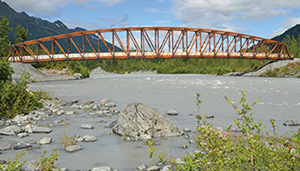
Glulam Timber Truss Spans Remote River
The Placer River Pedestrian Bridge in Chugach National Forest, Alaska, is the longest clear-span glulam timber truss bridge in North America. Constructed with preservative-treated Douglas fir glulam trusses, Alaskan Yellow Cedar decking, and steel connectors, the 280-foot camelback bridge was designed and fabricated by Western Wood Structures. Bridge designers faced unique challenges: The US Forest Service wanted the bridge to evoke early 20th century railroad culture in looks; the remote bridge also needed to withstand harsh Alaskan winters, and sit high enough to avoid collisions with icebergs from nearby Spencer Glacier. Completed in July, 2013, the cost-effective bridge design fit every requirement for toughness and good looks. “People are pleased with the bridge — with the way it looks and with the way it fits in with the setting,” says Rod Dell’Andrea, a structural engineer for the USFS. “It’s truly a context-sensitive design and installation.”
- Photo courtesy of Neil Hunt, Patrick Engineering
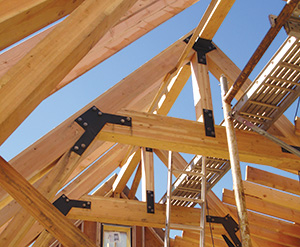
Glulam Provides Superior Strength and Aesthetics
Nestled in the resort town of Snowmass, Colorado, the Snowmass Transit Center is no ordinary bus stop. The structure has an upscale-lodge-like feel that plays to its locale. The center provides a cozy, warm and dry area for skiers waiting for bus transportation to nearby ski lifts or to Snowmass itself, a popular dining and shopping destination. The transit center is full of exposed wood beams that crisscross the ceiling, making it look more like an après-ski lodge than a typical bus stop. However, unlike most lodges, the Snowmass Transit Center does not use natural timber, which would not have been strong enough for the structure. Steel, while stronger, was never an option because it "was not part of the design aesthetic," states Christopher O’Hara, principal, Studio NYL Structural Engineering.

Glulam Blends with Local Neighborhood
Located on the Millennium Line of Vancouver, B.C.'s automated light rail rapid transit system, Rupert Station features spruce glulam beams over the platforms and in the roof of the transit building. Designers were looking for a structure that was warm and modern but would fit into the historical neighborhood of warehouses featuring heavy timbers. Glulam fit the requirements for the station building as well as for the canopy protecting customers from inclement weather.
- Photo courtesy of glulam manufacturer Western Archrib, Edmonton, Alberta
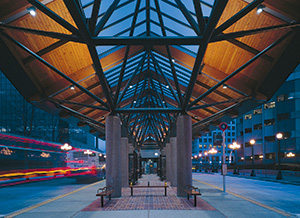
Glulam Encourages Creative Designs
The glulam roof and ridge skylight of the bus terminal in the large Seattle suburb of Bellevue, Washington, covers 14,000 square feet, offering rain protection while maintaining natural light by day. The 7,000 people who depart from ten bus bays at the station on a typical weekday are greeted by a tree-like design, with precast concrete columns serving as trunks, tubular-steel branches, and a glulam roof canopy.

Glulam Stands the Test of Time
Atlanta, Georgia's Indian Creek Transit Station serves both bus and surface rail lines with a rustic feel architects achieved using glulam stained light gray and pressure treated to match the surrounding area. Project managers encased the ends of the glulam beams with stainless steel caps and made structural connections of stainless steel in an effort to minimize maintenance. It worked; the project, completed in 1993, hasn't required any maintenance since.
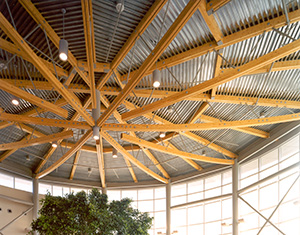
Strength to Span Large, Open Spaces
The baggage claim building was one of three that architects designed using glulam in Victoria, B.C.'s new airport terminal. Spruce glulam met designers' goals of creating a facility that reflects the community and its place in the world. The British Columbia region is a major wood producer, so designing with glulam supported the local economy. Project managers hope the glulam trusses in the airport convey a sense of the region from the moment visitors emerge from their planes.
- Photo courtesy of glulam manufacturer Western Archrib, Edmonton, Alberta
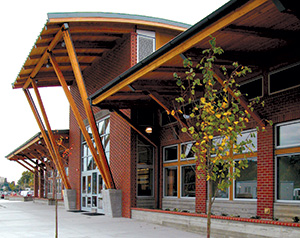
Glulam Simplifies Construction
The AMTRAK train, Greyhound bus, and local bus routes all converge at one place in the small town of Mount Vernon, Washington. For the new multi-modal structure, designers incorporated glulam beams into a classic train station design with large overhangs and awnings to accommodate waiting travelers outside. The building's roof features pre-assembled glulam open-web trusses, which contractors said were quick to erect and easy to work with.

Classic Design in a Modern Station
Back Bay Station in Boston, Massachusetts, offers bus, surface rail, and underground rail lines, serving more than 50,000 people every day. Eighteen pairs of glulam radial arches spanning 65 feet welcome visitors to the station, which was designed to recall the grandeur and spaciousness of railroad stations of the past. Project architects chose glulam for the warmth and aesthetics associated with exposed wood framing.
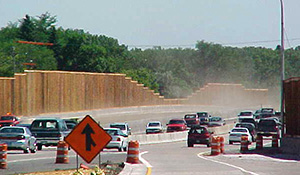
Durable, Cost-Effective Highway Sound Barriers
Glulam can also be used as sound barriers in areas where noise control is a concern, particularly in areas near transportation facilities. Requiring little maintenance, glulam beams also offer the warmth and noise reduction of wood in residential neighborhoods, while providing the strength, durability, and low cost of wood.